Dogs are naturally curious creatures, often exploring the world with their noses and mouths. This curiosity can sometimes lead them to unexpected encounters, like discovering a dead bird. While it may initially seem harmless, the question of whether to be concerned arises.
In this blog post, we will delve into the potential risks and reasons for worry when your dog consumes a deceased avian friend.
The act of a dog eating a dead bird can pose several health threats, ranging from bacterial infections and parasites to toxic substances. It’s essential for pet owners to be aware of these dangers and know how to respond to protect their furry companions.
We will explore the signs to watch for, immediate steps to take, and long-term preventive measures to ensure your dog’s well-being.
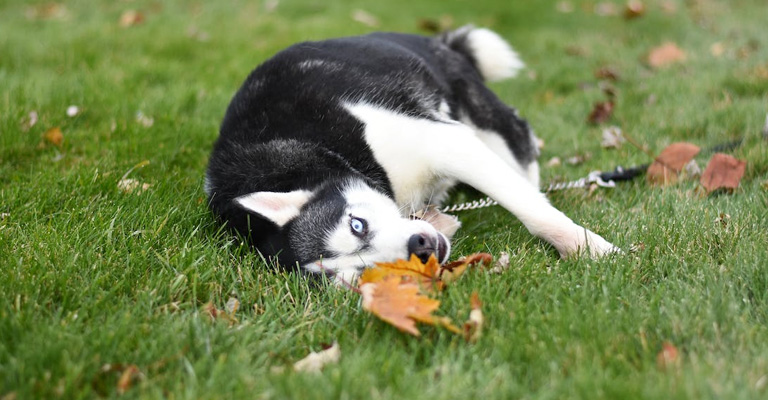
Why Do Dogs Eat Strange Things?
Dogs may eat strange things for a variety of reasons, and this behavior is often referred to as pica. Pica is the consumption of non-food items, and it can be a common and perplexing behavior in dogs. Here are some reasons why dogs might eat strange things:
Exploration and Play
Dogs, especially puppies, use their mouths to explore the world. Chewing on different objects can be a way for them to investigate their environment and learn about the textures and tastes of different items. It’s a natural part of their curiosity.
Nutritional Deficiency
Sometimes, dogs eat non-food items in an attempt to satisfy a nutritional deficiency. If a dog’s diet lacks certain essential nutrients, they may seek out alternative sources, even if those sources are unusual. In such cases, it’s crucial to provide a balanced and appropriate diet.
Behavioral Issues
Some dogs may develop pica due to underlying behavioral issues, such as anxiety, boredom, or stress. Chewing on objects can be a coping mechanism for dogs dealing with these emotions.
Attention-Seeking
Dogs are social animals, and they often crave attention from their owners. If a dog learns that chewing on strange objects gets them attention, even if it’s negative attention (such as being scolded), they may continue the behavior to get a response from their owners.
Medical Conditions
Certain medical conditions, such as gastrointestinal problems, dental issues, or parasites, can lead to pica. In these cases, dogs may be trying to soothe discomfort or address an underlying health problem.
Genetic Factors
Some breeds are more predisposed to pica than others, possibly due to genetic factors. Certain breeds may have a higher tendency to chew on non-food items.
Environmental Factors
Dogs that are exposed to a cluttered or chaotic environment may be more likely to ingest objects they shouldn’t, simply because they have access to a wide range of items.
Habit
Once a dog starts eating strange things, it can become a habit that’s difficult to break. The behavior may continue even after the initial reason for doing it has passed.
If your dog is consistently eating strange things or showing signs of pica, it’s essential to consult with a veterinarian. They can help determine the underlying cause and provide guidance on how to manage or modify the behavior.
Addressing any medical issues or underlying behavioral problems, providing proper nutrition, and offering mental and physical stimulation can help reduce pica in dogs. Additionally, training and management techniques can be employed to redirect the dog’s chewing behavior toward appropriate toys and objects.
Why Does My Dog Eat a Dead Bird?
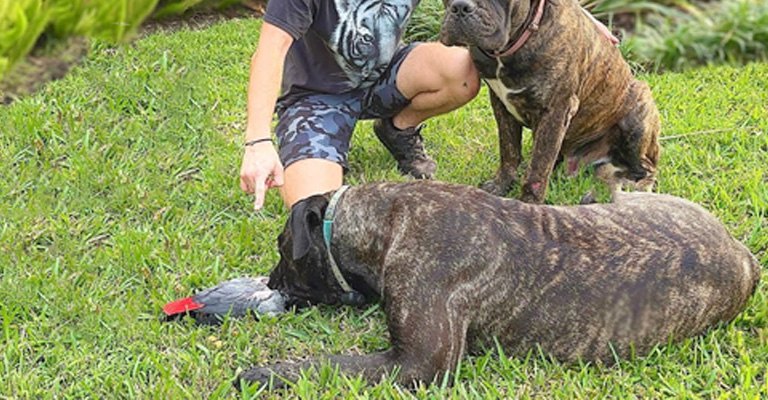
Dogs may eat dead birds due to their strong scavenger instincts inherited from their wild ancestors. In the wild, consuming carrion (dead animals) was a survival strategy to obtain nutrients.
Your dog might find the scent and appearance of a dead bird intriguing and instinctively view it as a potential food source.
Additionally, dogs rely heavily on their sense of smell, which can lead them to discover hidden or decaying prey. It’s essential to discourage this behavior, as dead birds can carry diseases or parasites that pose health risks to your pet.
Ensure your dog has a balanced diet, provide mental and physical stimulation, and supervise them during outdoor activities to prevent access to potentially harmful items. Regular veterinary check-ups can also help maintain your dog’s overall health.
Potential Dangers of Consuming Dead Birds
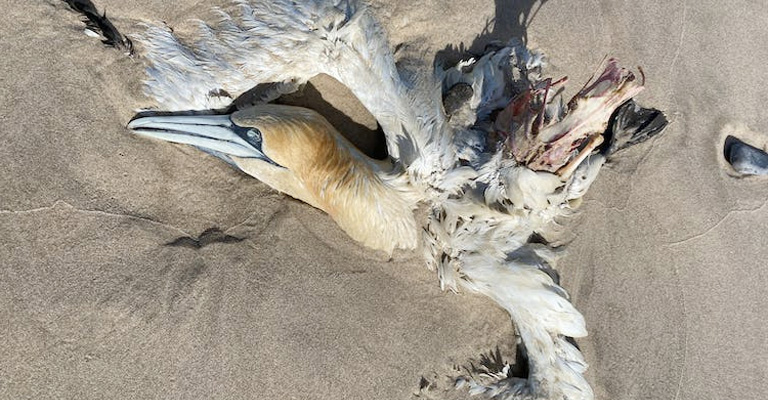
Consuming dead birds can pose several potential dangers to dogs:
Bacterial Infections
Dead birds can be infected with various bacteria, such as Salmonella or Campylobacter, which can cause severe gastrointestinal issues in dogs, including vomiting, diarrhea, and potentially life-threatening infections.
Parasites
Dead birds may host parasites like worms or ticks, which can be transmitted to your dog upon ingestion. These parasites can lead to various health problems and may require medical treatment.
Toxic Substances
Birds may have ingested toxins, such as pesticides, chemicals, or even contaminated food, which can be harmful to your dog if consumed.
Avian Influenza (Bird Flu)
While rare, there is a risk of dogs contracting avian influenza from infected birds. This disease can be severe and even fatal in both dogs and humans.
Choking Hazard
Bones and sharp parts of the bird can present choking hazards or cause internal injuries if ingested by your dog.
Upset Stomach
Even if the bird is not contaminated or infected, the consumption of unfamiliar or unusual foods can upset your dog’s stomach, leading to gastrointestinal discomfort.
Behavioral Issues
Eating dead birds can become a problematic behavior in dogs, leading to repeated scavenging and potential exposure to hazards.
It’s crucial to discourage your dog from consuming dead birds and other wildlife. Keep a close eye on your dog during walks and outdoor activities, and use a leash if necessary. Provide proper training and commands to prevent scavenging behavior.
If you suspect your dog has ingested a dead bird or is showing signs of illness after doing so, contact your veterinarian immediately for guidance and potential medical intervention. Regular veterinary check-ups can help ensure your dog’s overall health and prevent potential risks associated with consuming wildlife.
What to Do If Your Dog Eats a Dead Bird?
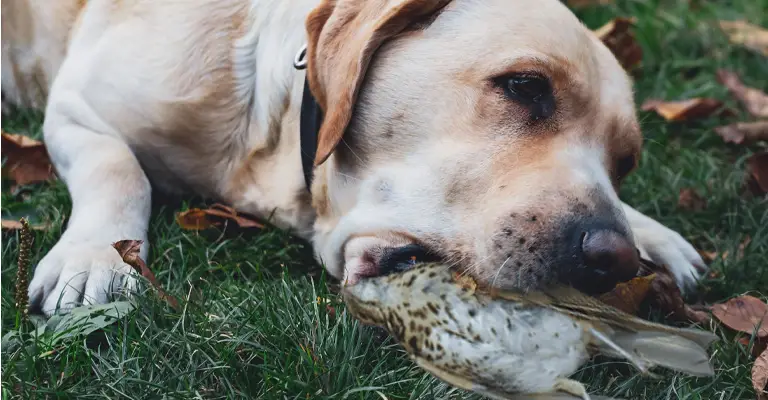
If your dog eats a dead bird, it’s important to take appropriate steps to minimize potential health risks. Here’s what to do:
Remain Calm
First, stay calm and try not to panic. While it’s a concerning situation, your reaction should be focused on your dog’s well-being.
Contact Your Veterinarian
Call your veterinarian or an emergency veterinary clinic immediately. They can provide guidance based on your dog’s specific situation. Be prepared to provide details such as your dog’s breed, age, size, and any symptoms or unusual behavior you’ve noticed.
Observe Your Dog
Monitor your dog closely for any signs of illness or distress. Common symptoms to watch for include vomiting, diarrhea, lethargy, abdominal pain, or any unusual behavior.
Do Not Induce Vomiting
Do not attempt to induce vomiting in your dog without explicit instructions from your veterinarian. In some cases, inducing vomiting can worsen the situation, especially if your dog has ingested sharp or harmful objects along with the bird.
Avoid Punishment
Do not scold or punish your dog for eating the bird. This can cause fear and anxiety and is unlikely to prevent the behavior in the future.
Prevent Further Access
Take steps to prevent your dog from consuming any more dead animals or other potentially hazardous objects. Keep your dog on a leash during walks, supervise outdoor activities, and practice reliable recall commands.
Maintain Hygiene
After handling your dog or any objects associated with the incident, be sure to wash your hands thoroughly to minimize the risk of disease transmission.
Follow Veterinary Advice
Follow the guidance provided by your veterinarian. They may recommend specific actions, such as monitoring your dog at home, bringing your dog in for an examination, or conducting tests to assess your dog’s health.
Remember that the ingestion of a dead bird can carry various risks, including bacterial infections, parasites, and toxins. Seeking professional veterinary care is essential to ensure your dog’s well-being and address any potential health issues promptly.
Your veterinarian will be able to determine the appropriate course of action based on your dog’s condition and medical history.
When Should You Seek Veterinary Help?
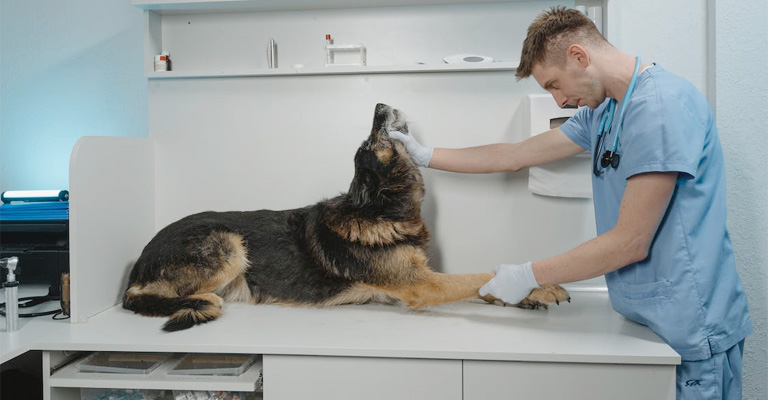
Seeking veterinary help for your dog is crucial in various situations to ensure their health and well-being. Here are some common scenarios when you should contact or visit a veterinarian:
Signs of Illness
If your dog displays symptoms of illness, such as vomiting, diarrhea, lethargy, coughing, sneezing, difficulty breathing, or any unusual behavior, contact your veterinarian. These signs can be indicative of underlying health issues.
Ingestion of Toxic Substances
If you suspect your dog has ingested a toxic substance, such as chemicals, medications, household cleaners, or poisonous plants, seek immediate veterinary assistance. Do not wait for symptoms to appear, as early intervention is critical.
Injuries
If your dog experiences injuries such as cuts, wounds, or fractures, or if they have been involved in an accident, they should be seen by a veterinarian for assessment and appropriate treatment.
Allergic Reactions
If your dog exhibits signs of an allergic reaction, such as swelling, hives, difficulty breathing, or severe itching, it’s an emergency. Seek immediate veterinary care.
Heatstroke
Dogs can overheat quickly, especially in hot weather. If your dog shows signs of heatstroke, including excessive panting, drooling, weakness, or collapsing, cool them down with water and seek veterinary help immediately.
Seizures
If your dog experiences a seizure, it’s important to consult your veterinarian. Seizures can have various underlying causes, and your vet can help diagnose and manage the condition.
Ingestion of Foreign Objects
If your dog swallows a foreign object, like a toy, sock, or bone, contact your veterinarian. Ingested objects can lead to blockages or other digestive issues.
Sudden Weight Loss
If your dog experiences rapid and unexplained weight loss, it could be a sign of an underlying health problem, such as a metabolic disorder or cancer.
Changes in Urination or Defecation
If your dog experiences difficulty urinating, blood in the urine, constipation, diarrhea, or any other significant changes in their bathroom habits, consult your veterinarian.
Behavioral Changes
Sudden and significant changes in your dog’s behavior, such as aggression, fearfulness, or extreme anxiety, may indicate an underlying issue requiring veterinary attention.
Routine Check-ups
Even if your dog appears healthy, it’s essential to schedule regular veterinary check-ups for vaccinations, dental care, and overall wellness assessments. These visits can help catch and address health issues early.
Age-Related Concerns
As dogs age, they are more prone to certain health conditions, such as arthritis, dental problems, and organ issues. Regular veterinary check-ups are essential for senior dogs to monitor and manage these age-related concerns.
Always err on the side of caution when it comes to your dog’s health. If you are unsure whether a situation warrants veterinary attention, it’s better to consult your veterinarian for guidance. Timely veterinary care can often make a significant difference in your dog’s prognosis and quality of life.
Tips to Train a Dog for Not to Eat Anything
Training a dog not to eat anything they come across, also known as “leave it” or “drop it” training, is essential for their safety and well-being. Here are some tips to help you train your dog:
Start with Basic Commands
Begin with basic obedience training commands like “sit,” “stay,” and “come.” These commands create a foundation for more advanced training, including “leave it.”
Use Positive Reinforcement
Positive reinforcement is the most effective way to train your dog. Reward them with treats, praise, and affection when they obey the “leave it” command.
Teach the “Leave It” Command
- Hold a treat in your closed hand.
- Show your dog the closed hand and say “leave it” firmly but not aggressively.
- Wait for your dog to stop trying to get the treat. Be patient; this might take some time.
- Once your dog backs off and stops trying to get the treat, immediately reward them with a different treat from your other hand.
- Repeat this process, gradually increasing the difficulty by using more enticing items.
Practice with Various Objects
Gradually introduce different objects, including toys and items your dog might find interesting. The goal is for them to learn to leave any object on command.
Use Distractions
Train your dog in various environments with distractions to reinforce the “leave it” command in real-world situations.
Safety First
Until your dog is reliably trained, keep them on a leash during walks or in areas where they might encounter harmful items or substances.
Consistency is Key
Be consistent with your training. Use the same command (“leave it”) and ensure that all family members are on the same page with the training approach.
Gradual Progress
Training takes time. Gradually increase the level of difficulty and distractions as your dog becomes more proficient in leaving items alone.
Be Patient and Positive
Avoid scolding or punishing your dog if they don’t obey immediately. Instead, reward and praise them for good behavior. Dogs respond better to positive reinforcement.
Seek Professional Help if Needed
If you’re having difficulty training your dog to “leave it” or if your dog’s behavior poses a safety risk, consider enlisting the help of a professional dog trainer or behaviorist.
Regular Practice
Continue to practice “leave it” regularly, even after your dog has learned the command. This helps maintain their obedience and reinforces good behavior.
Remember that training takes time and patience. Some dogs may learn more quickly than others, so adapt your training approach to your dog’s individual needs. Consistency and positive reinforcement are key to successfully teaching your dog to leave items alone and make safe choices.
FAQs
Yes, you should be concerned. Ingesting a dead bird can expose your dog to potential dangers like bacterial infections, parasites, and toxins. Contact your veterinarian to assess the situation and determine if any immediate steps or treatments are necessary.
Watch for symptoms like vomiting, diarrhea, lethargy, abdominal pain, or any unusual behavior. These can be indicators of health issues related to ingesting a dead bird. If you notice any of these signs, seek veterinary care promptly.
Yes, it’s possible. Dead birds can carry diseases, bacteria, and parasites that can harm your dog. Even if your dog doesn’t show immediate symptoms, it’s essential to monitor their health and consult your vet for guidance.
Contact your veterinarian immediately. They can provide guidance based on your dog’s specific situation. Do not induce vomiting or scold your dog. Keep a close eye on their behavior and health until you consult with your vet.
To prevent future incidents, keep your dog on a leash during walks, supervise outdoor activities, and practice commands like “leave it” and “drop it.” Regular training, along with providing mental and physical stimulation, can help redirect their attention away from such items.
Wrapping Up
In the event that your dog consumes a dead bird, prompt action and awareness are key. While there is reason to be concerned, a quick response, consultation with a veterinarian, and consistent preventive training can help mitigate risks and keep your dog safe.
Remember that the health and happiness of your canine companion are paramount, and being informed and prepared can make all the difference in addressing this unexpected situation.
Hopefully, you have got my point. Thank you for staying with us.